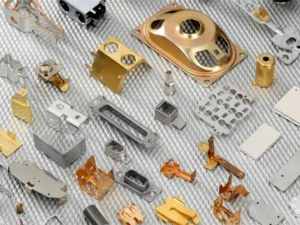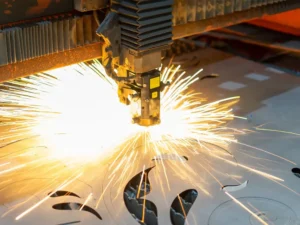Introduction:
Laser cutting is so popular largely because of its versatility. The fiber laser cutting machine is the main cutting machine used for cutting technology on the market. It is widely used due to its wide cutting range, fast cutting speed, good cutting effect, and maintenance-free. Especially in the cutting of sheet metal materials, fiber laser cutting machines have more advantages. So, what materials can be laser cut?
What Materials Can Be Laser Cut?
Fiber laser cutting machines can cut many materials but are not indestructible. Common processing materials for fiber laser cutting machines include stainless steel, carbon steel, aluminum, copper, titanium, etc.

Here is a summary of the materials that laser cutters can cut.
Carbon Steel
Carbon steel plates can be cut up to 25mm thick using laser technology. The oxidation flux cutting mechanism can be used to control the cutting seam of carbon steel within a satisfactory width range. The slit can be as narrow as about 0.1mm for thin plates.
Alloy Steel
Most alloy structural steels and alloy tool steels can be laser cut to obtain good edge quality. The cutting edge will be slightly oxidized when oxygen is used as the machining gas. For plates with a thickness not exceeding 4mm, nitrogen can be used as the processing gas for high-pressure cutting. In this case, the cut edges will not be oxidized. For plates with a thickness of more than 10mm, applying oil on the surface of the workpiece during processing can achieve better results.
Stainless Steel
Laser cutting is an effective processing method for manufacturing industries focusing mainly on stainless steel plates. Under the condition of strictly controlling the heat input of laser cutting, the width of the heat-affected zone of the cutting edge can be limited, thereby ensuring the good corrosion resistance of stainless steel.
Aluminum Alloy
For laser cutting of aluminum and its alloys, the auxiliary gas used is mainly used to blow away the molten products in the cutting area, leading to better cutting quality. Care should be taken for aluminum alloys to prevent microcracks on the slit surface. The aluminum alloys have high reflectivity and thermal conductivity, but aluminum materials less than 6 mm thick can be cut. This depends on alloy type and laser power. When oxygen is used, the cutting surface is rough and hard; the cutting surface is smooth when nitrogen is used. Pure aluminum is difficult to cut and can only be cut if a “reflection absorber” device is installed on the system. Otherwise, reflections can damage the optics.
Copper, Brass
Copper is highly reflective, making cutting with a fiber laser beam impossible. Higher laser power should be used when cutting brass, and air or oxygen should be used as the auxiliary gas to cut thinner plates. Both pure copper and brass have high reflectivity and very good thermal conductivity. Brass with a thickness of less than 1mm can be cut with nitrogen; copper with a thickness of less than 2mm can be cut, and oxygen must be used as the processing gas.
Titanium
Pure titanium combines well with the heat energy converted by a focused laser beam. When oxygen is used as the auxiliary gas, the chemical reaction is violent, and the cutting speed is fast. Using air as an auxiliary gas can ensure cutting quality. Laser cutting of titanium alloys commonly used in aircraft manufacturing has good quality. Although there will be a bit of sticky residue at the bottom of the gap, it’s easy to remove.
What materials cannot be laser cut?

Although fiber laser cutting machines have many good features, they are not everything.
- They can only be used to process metal and cannot be used to process non-metal materials, such as stone, cloth, leather, etc. The reason is that the wavelength range of the fiber laser cutting machine is no longer within the absorption range. This material is unsuitable for absorption and cannot achieve the expected effect.
- Secondly, fiber laser cutting machines cannot cut density boards. Fiber laser cutting machine is a thermal processing process. Cutting density board will cause burning, and the cutting edges will be burned and cannot meet the cutting requirements.
- There are also some highly reflective materials. These materials can be cut with a fiber laser cutting machine. However, the laser’s wavelength is outside these materials’ ideal absorption range. Some of the energy will be reflected, and the protective lens will be burned out. This is also something to note.
The Future Development Direction Of Fiber Laser Cutting Machines
The fiber laser cutting machine models currently on the market have obvious advantages, mainly for thin plate cutting. For example, they can precisely process carbon and stainless steel below 20mm. Thick plate cutting is the future development direction. Fiber laser cutting technology has developed along with the development of the sheet metal processing industry and plays an important role in promoting the progress of social production.
In addition to ordinary laser cutting machines, the demand for high-performance laser cutting systems such as high-speed and high-precision laser cutting machines, large-format thick plate laser cutting machines, and three-dimensional CNC cutting machines is also increasing.
In the future, laser cutting machines will undoubtedly develop in the direction of high power, large format, high efficiency, one-time molding, and high intelligence. They will be widely used in locomotives, heavy industry, etc. They bring high efficiency and high-quality production to most users. The ultra-cost-effective laser cutting machine is the best choice for the processing industry.
